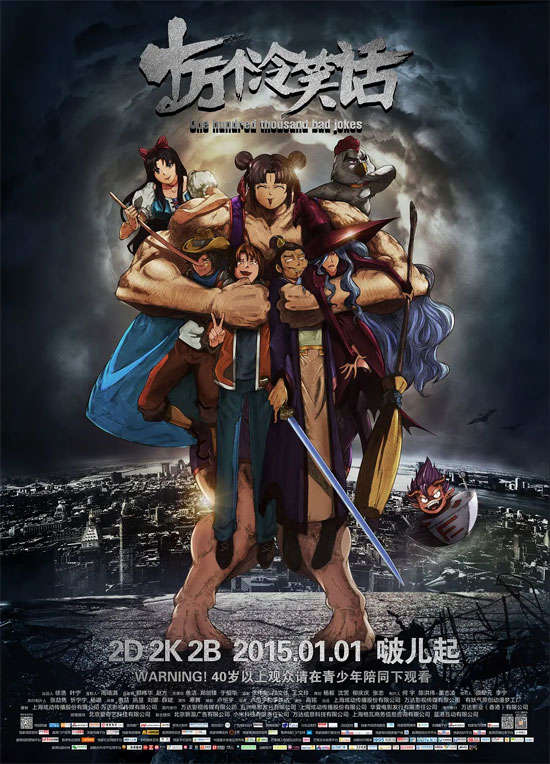Film Name: 十万个冷笑话 / One Hundred Thousand Bad Jokes / 100000 Ways To LMAO

First, a few thoughts on the viewing experience. This was my first time seeing a theater screening a domestic animation with over 90% occupancy. It was my first time seeing so many young men and women—who supposedly never watch domestic animations—watching a domestic animated film with genuine interest. It was my first time seeing every single audience member wait until the end credits finished before leaving. In short, this was my first clear glimpse of what a fan-driven film looks like and its power. From now on, stop saying young people don’t watch domestic animations.
Compared to today’s market of big-budget 3D CG animations, “One Hundred Thousand Bad Jokes” was produced on a relatively low budget. Yet its content far surpasses many other animations.
First is the pacing. The film moves at a brisk pace, never lingering unnecessarily on a single scene. If something can be explained in two seconds, it won’t take five. The dialogue pace is similarly brisk, catering perfectly to younger audiences. This high-speed narrative delivers massive information density, naturally demanding intense viewer focus. Some children’s animations, while adjusting speech speed for young viewers, suffer from overly sluggish pacing and sparse plot details—inevitably inducing boredom.
Second is the IQ factor. The film delivers creative plot twists that surpass audience expectations—the so-called “I never saw that coming” moments. These repeated surprises quench viewers’ thirst for excitement, draw them in, and foster affection and even admiration. American blockbusters often achieve this through unexpected scenes or designs within relatively fixed narrative patterns; Japanese animation, with its largely similar character designs, achieves it through unexpected worldviews. Ten Cold achieves this through unexpected plot twists. Beyond the pairing of Pinocchio and Snow White, elements like Little King Kong’s family background and the protagonist’s rescue from a black hole deliver genuine surprises. The film’s intellectual depth is crucial—if the director can’t match the audience’s intelligence, why bother making the movie at all?
When discussing the Ten Cold Cases, it’s hard not to mention the culture of satirical commentary beloved by the anime and manga community. But what exactly is satirical commentary?
First, it’s about freedom of speech. Whether it’s the freedom to say whatever comes to mind or the content of those remarks, satirical commentary ultimately reflects the principle of free speech. This mirrors another cultural phenomenon within the anime and manga world: parody. However, in China, satirical commentary still has its taboos. In Western animation, satire often targets politics, politicians, social elites, and those wielding influence—something we still can’t quite do here. When Taiyi Zhenren gets mocked as “Tai2 Zhenren,” it’s mostly just playful banter about ancient figures.
Second, it’s a form of “forced association” in quotation marks. Toucao often forces unrelated things together, yet somehow sparks logic. It can generate a series of unexpected explanations and critiques from a single phenomenon. The “cold humor” of “One Hundred Thousand Bad Jokes” actually lies in this state of spontaneous, arbitrary logic. Otherwise, you couldn’t understand the “logic” of Snow White and Pinocchio falling in love, or explain Nezha’s physique. Sometimes, this “far-fetched connection” is how the anime/manga subculture perceives the world—toucao merely articulates this logic with flowery speech.
Thus, viewing Ten Cold requires seeing it through the lens of subculture enthusiasts, observing how this new generation deconstructs and reconstructs the world. Working for others, pulling overtime without pay, the Time Chicken controlling a time machine that can rewrite history at will, and that nameless “Toucao Hero” capable of blowing up the entire world—these are all representations of this very group. Only then will you realize that the “cold jokes” in the film aren’t just nonsense, and the various Toucao moments aren’t meaningless.
Finally, a word of advice: while deconstructing the world, be mindful of copyright issues. While watching the Ten Cold series, I questioned why it could so brazenly use material from The Little Watermelon Brothers and even perform revolutionary adaptations—doesn’t this infringe upon the copyright of Shanghai Animation Film Studio’s classic work? On one hand, it’s a reinterpretation of classic animation within the anime subculture; on the other, it subverts traditional imagery, potentially undermining the brand value of Shanghai Animation Film Studio’s animations.
We also glimpsed fleeting references to “Spirited Away” in the train scene. The copyright for Chihiro and the No-Face character belongs to Japan’s Studio Ghibli—did they grant permission for this inclusion in an animated film? Or does China’s copyright law explicitly exempt such borrowings from infringement?
Personally, I believe “One Hundred Thousand Bad Jokes” deserves recognition as a form of deconstruction and reconstruction of the world by anime enthusiasts. However, when utilizing classic elements, if they are copyright-free content like Snow White or Nezha, you can use them freely. But when it comes to copyrighted works like The Little Watermelon Brothers or Spirited Away, caution is still warranted. After all, the aforementioned “far-fetched association” isn’t a license for reckless behavior.
Please specify:Anime Phone Cases » One Hundred Thousand Bad Jokes 2014 Animation Film Review: The Deconstruction and Reconstruction of the World by Anime Fans